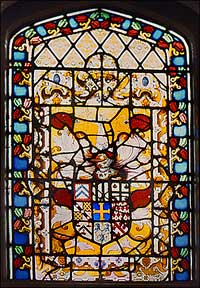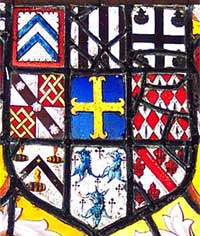|
(F) The so-called Italian Window In the old small dining room (room 42) - now a music room - is a stained-glass window dating from part of it dating from c.1700. This window shows a straight-sided “bluntly pointed” shield with helmet crest and mantling, and is done in enamel colours which are still amazingly sharp. The crest of a boar’s head erect argent with three ostrich plumes in the mouth covers the quarterly of nine achievement of either Sir Edward Tyrell (d.1605) or his son. |
|||
 |
1. "Argent two chevrons azure within a bordure engrailed gules" (Tyrell). J.H. Round in |
||
 |
|
||
|
6. “Lozengy ermine and gules” (Rokele). The coat of this family is often quartered with that of Prideaux-Brune. It is also worth noting that the family of Rockley or Roclay of Essex and Suffolk has the same achievement, with the coat of Tyrell in the second quarter and Hawkwood in the third. The fourth quarter is “Ermine an inescutcheon azure”. 7. “Argent a chevron sable between three tar barrels sable their bungs flaming proper” (Ingleton). The arms of the Ingleton (or Incledon) family, from Bampton in Devon come in through the marriage of Jane Ingleton to Humphrey Tyrell (see above). It is reported that Thornton was one of the 50 manors brought in by the marriage settlement. 8. “Argent crusily fitchee three griffins heads erased azure” (Ingleton). This is the second Ingleton coat (see above). 9. “Argent a bend between six fleur de lys gu1es” (Fitzelys). Lipscombe in his “History of Buckinghamshire” (Vol. 4, p.119) states that this is Fitzellis, whereas Burke gives this coat to Fitzelys of Waterpirie, Oxford. In Waterpirie church is a monument with Fitzelys quartered with that of Tyrell. Greening Iambourn in an article in “Bucks Archaeology” states that Robert Fitzelys, who died in 1470, had a daughter and heir, Margery, who married Thomas Billing and was the mother of Sybil, wife of George Ingleton, the son and heir of Robert Ingleton. |
|||